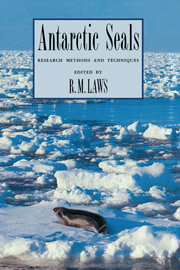Book contents
- Frontmatter
- Contents
- List of contributors
- Preface
- Introduction
- 1 Identification of species
- 2 Estimation of population sizes
- 3 Immobilization and capture
- 4 Marking techniques
- 5 Telemetry and electronic technology
- 6 Behaviour
- 7 Killing methods
- 8 Morphometrics, specimen collection and preservation
- 9 Genetic-based studies for stock separation
- 10 Collection of material for the determination of organochlorine and heavy metal levels
- 11 Age determination
- 12 Reproduction
- 13 Diet
- 14 Bioenergetics
- 15 Development of technology and research needs
- 16 Appendices
- Index
9 - Genetic-based studies for stock separation
Published online by Cambridge University Press: 05 February 2010
- Frontmatter
- Contents
- List of contributors
- Preface
- Introduction
- 1 Identification of species
- 2 Estimation of population sizes
- 3 Immobilization and capture
- 4 Marking techniques
- 5 Telemetry and electronic technology
- 6 Behaviour
- 7 Killing methods
- 8 Morphometrics, specimen collection and preservation
- 9 Genetic-based studies for stock separation
- 10 Collection of material for the determination of organochlorine and heavy metal levels
- 11 Age determination
- 12 Reproduction
- 13 Diet
- 14 Bioenergetics
- 15 Development of technology and research needs
- 16 Appendices
- Index
Summary
Introduction
Effective conservation of Antarctic seals requires knowledge of the relative discreteness of populations or stocks in different geographic areas. Studies of Antarctic seals carried out to date are reviewed by Laws (1984), and suggest that the terrestrial and fast ice colonial breeding species – the Antarctic and sub-Antarctic fur seals, the southern elephant seal and the Weddell seal – may be composed of several or many relatively small, more or less discrete populations. The more solitary, pelagic species – the crabeater, leopard and Ross seals – may be composed of only one or at most a few relatively large, panmictic populations. Available data are insufficient to confirm these suggestions or to determine the number, sizes and geographic ranges of populations comprising various species.
Possible means for discrimination between populations
Determination of the degree of isolation between seals from different geographic areas can be approached directly, by mark–resighting and/or radio tagging and tracking to ascertain home ranges, dispersal distances and migration patterns, and indirectly by assessment of possible environmental-related and genetic-based variables. Direct methods for determining population discreteness are of limited use in the Antarctic because the area is remote, there is little air or ship traffic, and the seals are not being commercially exploited. Mark-resighting programmes, for example, are of little use, except in the vicinity of coastal scientific stations, because the lack of ship and air traffic makes tag resighting difficult. Similarly, while radio tagging and tracking have been and can be used to study local movements and activity patterns, they cannot be used effectively to assess at-sea movements and movements in the vast pack ice ecosystem unless, and until, satellite-linked tracking capability is developed (see chapter 5).
- Type
- Chapter
- Information
- Antarctic SealsResearch Methods and Techniques, pp. 172 - 193Publisher: Cambridge University PressPrint publication year: 1993



